Robyn Annear, by the author. This image is copyright.
On the 30th November I had the pleasure of joining historian Robyn Annear on a guided walk around the north-western corner of Hoddle’s grid in Melbourne as part of the soft launch of her new book of seven walking tours titled “Adrift in Melbourne”. Funny, erudite, and witty, Robyn had an enthusiasm that brought characters to life. One of our stops was outside where Holt’s Matrimonial Agency once stood, opposite the location of the Old Melbourne Cemetery, now the carpark for the Victoria Market.
Holt’s commenced business around 1887 at 2 Latrobe Street west.* A few years later they were at 44 Russell Street on the corner of Flinders Lane, then 28 Russell Street. This last address was likely merely a renumbering that occured in the city in the late 1880s as it was still described as being on the corner of Flinders Lane. However, advertisements in late 1889 put it back at 44 Russell Street. By mid 1890 they were located at 345 Swanston Street, opposite what we know as the State Library.**
The Holt’s also ran a Labor hire agency from Queen Street, opposite the old cemetery, from March 1887, and the Russell Street and Swanston Street addresses from January 1889 until April 1892 at the height of the depression. A Holt’s Tourists’ Bureau also operated from 104 and 144 Elizabeth Street (possibly street re-numbering again) from mid 1888, the height of the boom period, until around February 1891. Was this run by the Holt’s of later marriage bureau infamy? I can’t say at this stage but the modus operandi certainly suggests that. As the 1890s depression deepened, a tourist bureau and labor company were clearly not going to survive. There was no work available and businesses didn’t need a bureau to help them find labor when destitute men were knocking on their doors daily. The thing that did keep going when banks were busy foreclosing on homes or shutting down themselves was a matrimonial agency.
The approximate location, according to current numbering, of 448 Queen St, courtesy of the Public Record Office’s MapWarper program.
After surviving the depression while located at Swanston Street, in early April 1895 the Holt’s matrimonial agency moved to 422 Queen Street, their old stamping ground opposite the old cemetery where we stood with Robyn Annear. Advertisements bragged that the “New Matrimonial Chambers had been “specially erected” by [the] “proprietors” … “costing £4000. A later address still was 448 Queen St, which we believe to be the same location. These addresses are important for family history researchers as the marriage certificate may not have noted that the event occurred at the Agency. The only clues may be the address and sometimes the names of witnesses who may have been Holt family members or employees. The Holts had purchased the Swanston St property a few years earlier when they were advertising a cottage located on the block for rent. In preparation for their “new beaut” building, Holts advertised for demolition of three cottages on the block and presumably two on neighbouring blocks.
The Holts in this case were James and Annie Holt. Ann McLeod Holt (1860-1946) was the daughter of drunkard and family deserter Alexander Hossack, and his wife Bridget aka Bertha Fitzgerald. Annie must have had a very rough upbringing. When Bertha brought a court action against Alexander in Williamstown in 1867 she stated that he “had turned her and her three children aged respectively seven, four, and three years – into the street, and then locked the door on them. She also alleged that he was a man of dissipated habits, and that his conduct to her was unbearable. Hossack, on the other hand, said that his wife was indolent and neglectful, and, in addition to her violent temper, she had a strong liking for beer when in company.” Nevertheless, the pair went on to have ten children, Annie being the second child. She was born in Ashby, Geelong in 1860 and the family moved to Williamstown soon after, where Alexander plied his trade of a [metal] polisher. Things were not much better in July 1887, May 1891 and May 1893 when further actions were brought against Alexander for maintenance. When James Holt married Annie in 1885 at South Melbourne Presbyterian Church he gave his occupation as a brass finisher. Somehow the occupations of the two families had connected them.
Part of the marriage certificate of James Holt and Annie McLeod Hossack, 1885. Note the signatures of James and Annie.
According to their marriage certificate, James Holt was born around 1854, in Glasgow, Scotland to John (also a brass finisher) and Jeannie Lee. Holt’s background is much more opaque than that of his wife. No record can be found of his birth, no brothers appear to have accompanied him to Victoria, and his parents cannot be identified as having died in Victoria. In electoral rolls between 1903 and 1919, James described himself variously as an artist or an agent, but when he died at 448 Queen Street in 1921, Annie determined to refer only to his respectable past, describing him in the death notice as a “repousee artist”. James was known for his high end brass work which he continued to produce whilst also running the matrimonial agency, as well as teaching the metal art at the Working Men’s College. Together with Henry Simkin, a silversmith, James produced several notable works, here, and here. James and Annie Holt produced only one child, a son James Alexander Blair Holt, born in 1886. When Annie died in 1946 she was living at The Esplanade, Brighton Beach and had an estate valued at over £17,000. She was also sporting her new posh surname of Blair-Holt which her son first acquired around 1913.
Early Holt’s advertisement, Cobram Courier, 15 September 1887, p7
Holt’s Agency is an interesting subject as it has lived on in history, mainly for it’s dodgy dealings and blind eye turned to bigamy, under-age marriage and other assorted scandals which sometimes ended in court. Many other marital agencies operated in Melbourne but Holt’s is best known as it survived for so long, including through both the depressions of the 1890s and 1930s, and for it’s relentless advertising and court appearances. Holt’s establishment was a Registry Office, where the ceremonies were conducted by clergymen. In fact, the business always advertised that parties to any marriage would be married by “ordained clergymen”. I would have thought that you couldn’t be a legitimate clergyman unless you were ordained, so the emphasis is interesting. Were they promoting that it was a religious ceremony rather than a Registry Office event, putting themselves at loggerheads and in oppostion to mainstream or “real” churches? Or were they trying to convince a sceptical public that their marriages would be legal, and weren’t as cheap and nasty as the court cases portrayed them? Or both? Nevertheless, the Free Christian Church, was by the 1890s closely aligned with the marital agency and seemed to be a neat creation that served their purposes in many ways.
The Holt-associated version of the Free Christian Church first appeared in Fitzroy in 1883 when the Reverend John Alexander Dowie gave the inaugural sermon in the Fitzroy Town Hall. Of note is Dowie’s pamphlet titled “Sin in the Camp”, “being an account of nine months’ work in the Tabernacle, Sackville-street, Collingwood, And a Vindication of Character, In consequence of scandalous attacks by Mr. C. M. Cherbury and others.” Hmmm, so the character of the first minister of the Free Christian Church was being attacked before his inaugural sermon. Not a good start for him. By 1884 the church was in full swing with huge meetings that packed out the building in Johnston Steet, Fitzroy. Most notable of all the discredited clergyman who took part in proceedings of the FCC was Nathaniel Kinsman, founder of the Victorian Free Church of England in the 1860s, who appeared there in 1884. Kinsman was at first an auctioneer and agent who went into the business of shonky marriages two decades earlier than the Holts. By September 1890 Albert Abbott was preaching for the church in York Street, Fitzroy. The Church provided much fodder for newspapers as reporters revelled in the scandals and internal dysfunction. The report below is from 1893 when the 1890s depression was biting hardest. It reveals that the church had been reinvented or re-established a few times in the preceding years.
In spite of the abominable weather of Wednesday evening, it was washing-day in Collingwood. The public labour under a vast debt of gratitude to the Free Christian Church of Collingwood. For the third time within almost as many years that estimable if not very united body has furnished one of those spicy little disputes … The meeting of the congregation on Wednesday evening lacked nothing either in excited controversy or in those more humorous elements … A meeting of shareholders in a defunct land company could hardly have conveyed it better idea of Pandemonium. Many people will argue that the tone of the Free Christian Church meeting was hardly Christian. But it was certainly free – very free. Still the little congregation at Collingwood may fairly be trusted to work out its own salvation. This is the third attempt, and as there is luck in odd numbers one has reason to hope that the white-winged dove of peace may once more roost among the rafters of the Collingwood Tabernacle. There is the more chance of this because on one side, at least, the matter seems to have been surveyed from an eminently practical point ot view. Thus we have the absent pastor [Abbott] frankly confessing that he did kiss the young girls, and, with that candour which distinguishes the accomplished man of the world, adding, ”What other man would not do the same?” This is the sort of sound common sense that ought to bring matters to a speedy close, one way or another.
A typical headline in a Holt’s bigamy case. No matter how many court cases there were, the press insisted on terming them “remarkable”.
Despite this clear connection to the Free Christian Church, ministers from other denominations also performed ceremonies there. One wonders how and why they became involved with a business that seemed to be running the nineteenth century equivalent of marriages by Elvis Presley impersonators in Las Vegas. One court case in November 1897 heard that a man charged with bigamy after marrying at Holt’s had “pleaded guilty, but stated in extenuation that his wife left him and took up with another man with whom she is now living, and that he met Ethel Yates in the street and had a drink with her, and got married at Holt’s matrimonial agency after a three days’ acquaintance. It was shown, that the woman Yates was of bad character, and that she had returned to the streets from which the marriage had temporarily rescued her.” It is interesting, that although the man was charged with bigamy, only the morals of the women were up for open discussion and condemnation, although the judge did sum up in this case that both women had been wronged by Holt’s. The issue of sex or street workers is a not uncommon refrain in the court cases surrounding Holt’s Matrimonial Agency. When Elizabeth Stewart summoned her husband James for maintenance after his desertion, a letter from her stating that “she could get her living on the streets of Melbourne” was tendered in evidence against her.
Part of an 1898 marriage certifcate from Holt’s. Notice how Annie’s signature has become more refined and confident. It is identical to many other examples I have seen from the 1890s, but nothing like the signature on her own marriage certificate.
When Jane Wright’s charge of bigamy against her spouse came to court, her husband Henry was described as “very much married” and evidence presented to the court indicated that marriage at Holt’s was considered a joke by some. Despite not long after his marriage to Jane, admitting that he was already married, Henry had intentionally described himself as a bachelor on the marriage certificate. Henry had married his first wife, also at Holt’s only four years before. The large number of blatant bigamy cases arising from marriages conducted at Holt’s, clearly affronted the legal establishment. However, it seems that this lack of seriousness about the nature and sanctity of marriage also affronted established churches and society in general. These were people, after all, who refused to be constrained by the law or by the self anointed moral guardians and controllers of society.
It’s not surprising that marriages were entered into with so little thought. Not only were Holt’s deliberately appealing to the lower echelons of society, they also advertised daily for spouses, inducing people with claims of wealthy prospective partners, who likely never actually existed. They conducted marriages with no notice, at any time during the day and into the evening, and they regularly conducted marriages where one or more parties were too drunk to recall the event the next day. Holt’s also produced a monthly “Matrimonial Gazette”, where for the price of a two penny stamp, one could be sent the publication which outlined the “particulars of available clients” to peruse in the the privacy of your own home. Agitation against agencies like Holt’s were a regular feature of court cases. In November 1897 one judge hearing a bigamy case noted that the couple in question were married at “one of those rascally places still permitted to blight this community-Holt’s Matrimonial Agency.”
For all the negative attention the Holt’s attracted over the decades, they were never charged with anything. Bigamy and under-age marriage was a crime committed by the actual participants, not the witnesses or people who assisted them. So a 15 year old girl could be charged with making a false declaration, but her 32 year old husband who had clearly misused the power imbalance could get away with his coercion. Ministers usually fell back on saying that they did not think the girl looked under-age, and that they felt her declaration absolved them of all responsibility. The Holt’s, for their part, had a stock standard answer that was used in countless court cases. It amounted to “Yes, that is my signature, but I have no recollection of that ceremony and do not recognise the parties to it.” Even though it was illegal to marry an under-age person without parental consent, this did not make the marriage null and void. Young teenage girls would thus be termed Mrs Smith because technically they WERE married, even though the consent technicality was not fulfilled. I assume authorities were frightened that the girl would be pregnant, and having a law that made her marriage void would have put her in a dire predicament with no husband to sue for her personal maintenance.
One 1897 editorial tackled the problem of matrimonial agencies head on.
Marry in haste and repent at leisure is an ancient proverb which Victorian legislators perseveringly sought to bring up to date by making the repentance as speedy as the marriage. … The public are still old-fashioned enough to be scandalised when an undertaker invents a “church” and gets himself registered as a “minister of religion” qualified to celebrate marriages.*** But they tolerate shop-keepers and “matrimonial agents” keeping some wretched, discredited, real minister to perform the ceremony of marriage, with about as much devotional spirit as the historical blacksmith of Gretna Green. … marriages in Melbourne are as much an aid to immorality as were the Fleet marriages in the London of the eighteenth century. … As might be expected, the trade of ” splicing couples officially,” to use the terms of a witness in a recent Police Court case, has led to the establishment of matoimonial agencies to keep up the supply of couples. Naturally, love and affection or the “soul’s affinity ” are not attractions for those foolish or sordid people whe can be induced to pay fees for an introduction “with a view to matrimony.” The bait is always money. Either party wants money, and is willing to take the encumbrance of wife or husband as an unavoidable adjunct. Fortunately for public “morality, the police have the power, and are vigilant in exercising it, to prevent matrimonial agency being a cloak for the nefarious practice of procuring, but they cannot prevent people making fools ofthemselves in their sordid greed for money. Now and then some miserable victim exposes his or her folly and woes in the law courts, but most bear their punishment in private. There are a good few men paying alimony to “widows of means,” who, after marriage, proved, to have no other means than the skill to befool the man into believing that they had money.
One particular thing that Robyn Annear said on our walking tour caught my interest. She mentioned that Holt’s engaged an assortment of “dubious old dudes” to act as marriage celebrants for the business. I thought it would be interesting to have a look at some of these men and see what tales they could tell.
Pastor Abbott, Weekly Times, 24 February 1906, p24
Abbott, Albert James– Abbott conducted marriages at Holts from at least Sep 1890 when he was also the preacher at the Fitzroy based Free Christian Church. In August 1900 Abbott admitted that he had previously been charged with trying to kiss a congregation member and had therefore been removed from his church. Abbott was still up to his tricks in May 1898 when he presided at the marriage of a woman because she stated that she had been deserted by her husband for 13 years. He must have had a poor memory as he appears in the courts several times in cases of bigamy where both the first AND second marriages of the accused were conducted by him at Holt’s. After a grilling in court, Abbott claimed in May 1902 to have disassociated himself from Holt’s six months previously, yet he later appeared in a bigamy case for a marriage that he presided over at Holt’s in October 1902. He was described as “head of the Free Christian Church” in December 1902 and in May 1905 as a clergyman with the FCC but it is unknown if he continued to celebrate marriages at Holt’s. Perhaps he had enough work performing shonky marriages through the FCC.
Abbott moved on to the Melbourne Christian Assembly where he acquired the title of Professor. In 1906 he was sensationally attacked during a service by a woman named Mrs Rebecca Haldane who hit him with an umbrella. Mrs Haldane was a friend of Abbott’s estranged wife, whom he subsequently publicly slandered, claiming that he had married her and had three children with her, unwitting to the fact that she had been previously married. Abbott then moved to Sydney where his fire and brimstone sermons were often thinly veiled, or open attacks on other evangelists. Never one to be proven wrong or beaten in any imagined competition, Abbott declared in 1934 that “he was a gold medallist in theology; that he had the record in Australia in marriages— he had celebrated 14,000; and that he refused to take money for preaching the Gospel.” Born in Devon, England around 1854, Abbott died in East Brunswick in 1941 aged 87. Such was the oblivion to which he had sunk, not a mention was made in the press of his passing. One lonely family notice from two devoted parishioners was all that marked his passing.
Angus, Robert – Angus, fresh from Scotland, first appeared in Victoria as a guest minister at a St Kilda Presbyterian church in January 1880. For several years he moved around the Ballarat, Castlemaine and Maldon regions before heading to Melbourne where he started working at Holt’s between 1895 and 1896. When he first came to notice performing marriages at Holt’s he declared that he had been a Presbyterian minister for 35 years and had been celebrating marriages In Victoria from about 1879. A solicitor, however, noted in the court that “Mr. Angus was not certificated, had never been gazetted, and was not an incumbent of any church.” The solicitor was correct, but Angus was a minister of the Presbyterian Church, although churchless. That organisation admonished Angus and directed him to cease all marriages in matrimonial agencies, which he accepted. Angus was unlikely to have made a living working at Holt’s as he claimed that he was employed there for 10 to 12 hours per week and earned only 25 shillings per week. This caused a deal of angst amongst clergy, some of whom claimed it amounted to “sweating” and deliberately contributing to the reduction of wages amongst them. One letter writer to a newspaper sympathised with the plight of Angus, who without a church, he believed was forced to earn a living at Holt’s, “That it should be necessary for a clergyman of any church to hire himself to a matrimonial agency for a bare pittance is a thing to be deplored, and I do sincerely hope that the church … will find other work for him to do. It may be true Mr. Angus has a certain mannerism that tells against him … but as a conscientious, outspoken and devout Christian, I know of few who are his superiors.” Angus disappears from the Victorian scene at this time. Was he the old man who was found dead in his hut at White Point near Daylesford in December 1913?
Ferguson, Andrew Fergus – often known as Fergus Ferguson, he was the brother of the Rev. Samuel Hector Ferguson, known as Hector. Ferguson was a Presbyterian minister who worked for Holts in February 1906 through to 1908 at least. He came to the notice of the courts in 1908 when he married the same woman twice, only two months apart. In 1915 he was still performing dodgy marriages as an Independent Presbyterian, and this time an under-age case with a forged consent form landed him in court. Some family histories claim that Ferguson was operating as an “Independent Presbyterian” as he had been asked to resign from the Maryborough Presbytery in late 1897, with poor health being one of the factors cited, but a penchant for alcohol was also implicated. He married Catherine (Katie) Watt Brown in 1896 at Northcote Presbyterian Church, and died in 1917 at Cheltenham, aged 56.
Hamilton, Samuel Alexander – Hamilton Claimed in June 1897, at the age of 77 years, that he had been a Presbyterian clergyman for 50 years, having previously had an incumbency at Hay in New South Wales for 25 years, before arriving in Victoria around 1860. The next month the The North Melbourne Presbytery were tired of his bringing the church into disrepute with his dodgy marriages and subsequent court appearances, and “decided to take definite action in connection with the Rev. S. A. Hamilton, who has been celebrating marriages in connection with Holt’s matrimonial agency. The Presbytery has decided to inform the Rev.Mr. Hamilton that if he repeats the offence immediate steps will be taken to deal with him as contumacious. He is also requested to inform the Presbytery as to his connection as church minister, and when and where he last partook of the sacrament of the Lord’s Supper.” Hamilton died in October 1900 at the Queensberry Hotel in Carlton where he was living. He was aged 80. An obituary claimed that Hamilton was born in America and went to Ireland “where he was trained for the ministry, under his uncle, the celebrated Dr. Cook of Belfast.” A wife predeceased him in Hay, New South Wales.
A sensational headline in The Truth newspaper of one of Reverend Laver’s cases.
Laver, Thomas – Laver arrived in Melbourne aboard the ‘Tornado‘ from Tasmania in 1865. He was quickly ordained and took up the incumbency of the Hawthorn Congregational church. Born about 1840, he was in his late 60s by the time he started working for Holt’s between April 1908 and September 1909. On obituary upon his death in 1924 noted that he “had no station” for some time and had been conducting visiting sermons at various churches. Laver had been receiving support from the Congregational Ministers Provident Society in 1875 suggesting he had been ill. He also toured Queensland in the 1890s giving lectures, one of which was given in Brisbane, titled “Moral Photos”. Age, illness, and the decline of the Congregational Church may have combined to put Laver out of work and force him to look for alternatives in marriage bureaus.
Mackie, William – Mackie performed a marriage at Holt’s in August 1907 and the parties ended up in court in 1911 as that marriage was bigamous on the part of the husband. Police at the time noted that Mackie “had been struck off the rolls, and could not now be traced.” Mackie was formerly a fisherman and later Secretary of the Hastings Fisherman’s Union, before his transformation into an Elder of the Latter Day Saints Church in Richmond. He hadn’t, however, done anything respectable to cause his absence from court – such as dying. In 1908 he had deserted his wife and child In Albert Park, and run away to Sydney where he had tried to reinvent himself as a hairdresser in Balmain. Mackie was tried in Melbourne and found guilty. The Latter Day Saints promptly cancelled his license, and his wife declared in the trial that she didn’t want him back and didn’t want his money; she merely wanted what he had done to her publicised. While Mackie was serving his nine months with hard labor Mrs Mackie finished him off by disclosing his adultery in Sydney and succeeding in a divorce on those grounds. So where was he in 1911? We can’t say without a lot of further research, but he MAY have been the William Mackie, tobacconist and hairdresser who attempted to commit suicide in Brighton in 1913. Or he may have thought up a new alias to live under, as he did in Sydney, and removed himself from the state.
South, George Frederick – South was a Church of England clergyman residing at Upper Beaconsfield in 1897, but he had been in charge of parishes in South Gippsland previously. He last performed marriages at Holt’s in June 1897, but later that year he was called as a witness in a court case about a property transferred to Annie Holt by a widow. Mrs Holt claimed it was a gift, but Mrs Riddock claimed it was merely a security and could she please have it back. At that time, South stated that he was in poor health and “unable to endure the stress of regular parish work”. He was only about 63 years old, but evidently past being able to manage a posting. In 1898 South entered Kew Asylum, suffering from “delusional melancholia” presumed to have been brought on by “money troubles”. It was noted that he had some facial paralysis so had likely suffered a stroke. Where the admission record asked if he was dangerous the response “yes”. Still, South was discharged over a year later and lived out his life in Preston where he described himself as a clergyman on electoral rolls. He died in 1911 and is buried alone in a grave at Fawkner cemetery.
Strickland, Frederick Phillip – Strickland was quite an old man by the time he was spotted celebrating marriages at Holt’s in February 1897. Born around 1820, he was involved with the Geelong Free Church of England in 1861, having arrived from Adelaide in January that year. He retired from the incumbency of Geelong Trinity Church in 1875, acting on a long held change of heart in relation to his religious views. Two years later he moved to Tasmania to take charge of a Baptist church, evidently having switched allegiances. Strickland later took up the management of Coranderrk Aboriginal Station between 1878 and 1882. Ian Clark gave a detailed view of Strickland’s family and life in his book “A Peep at the Blacks’: A History of Tourism at Coranderrk Aboriginal Station”. Strickland found that he could not get a position in Melbourne after leaving Coranderrk so returned briefly to Geelong, before returning to Armadale to live with his daughters in 1885. Clark thought that Strickland performed marriages at his home but this was clearly not lucrative enough, so the temptation to work for an agency like Holt’s would have been high, particularly as he got older and was less able to drum up work. His cold and authoritarian personality (and that of his wife), as noted by Richard Broome in Clark’s book, would be another reason he was not a popular minister well into his dotage, and why he had difficulty obtaining an official paid position within the church. Strickland died in December 1901 aged 81 years.
After about 1910, as divorce became easier to obtain, and bigamy and under-age marriage was either less pursued in the courts, or less popular generally, mentions of Holt’s in newspapers became less frequent and direct. Apart from the most scandalous cases, the bureau was mostly only mentioned in relation to divorce cases where dry facts of the marriage were stated. The ministers conducting these ceremonies at Holt’s were thus not called as witnesses. Only bigamy and under age cases profiled the clergymen. The themes amongst the men who worked at Holt’s celebrating marriages are clear. They often did not have a church, and thus income of their own. This lack of income was caused by their own bad behaviour or insanity, or old age, or infirmity. The connection with the Presbyterian Church is also clear. Did the Holts deliberately target disaffected or ostracised Presbyterians? Or were the Presbyterians just more adept at removing their crazy ministers, who in turn were drawn to the Holts for an income?
* James Holt later gave 1886 as the date of establishment in an advertisement, and 1888 in a court case.
**Swanston Street was later re-numbered so this is now the address of the State Library of Victoria.
*** This refers to various scandals in the 1890s when anyone could start their own religion and be placed on the register of people authorised to conduct marriages with merely the signatures of 40 adherents of the new church. The “Reformed Church” was one such case. Holt’s was quick to jump on this scandal, that for once didn’t involve them, advertising that “Marriages celebrated at Holt’s Matrimonial agency are all carried out by ordained Clergymen of the highest integrity not by Undertakers or ironmongers under the guise of clergymen….’
Below is a list of other blog posts about Holt’s Matrimonial Agency.
Joseph Jewell Westwood in Beyond the Name

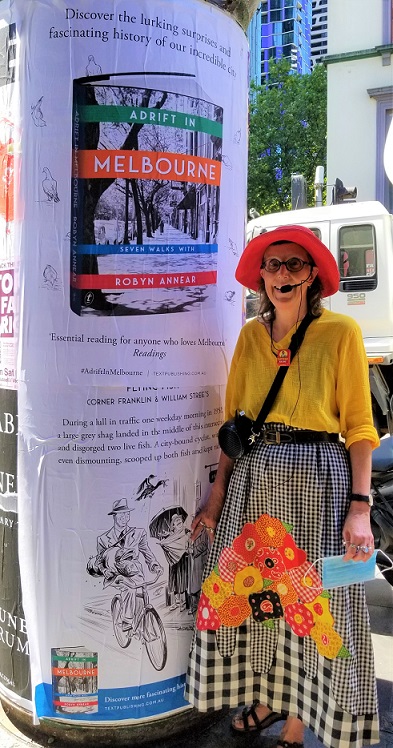



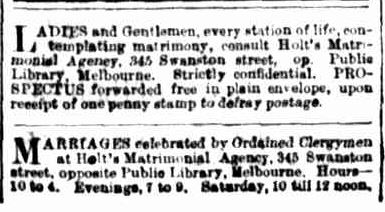
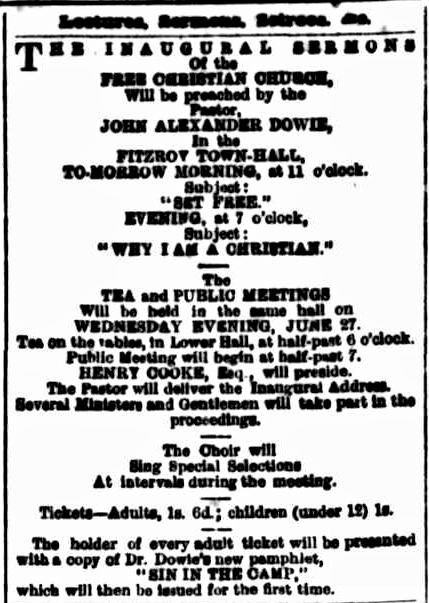
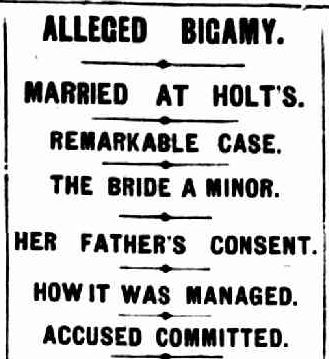

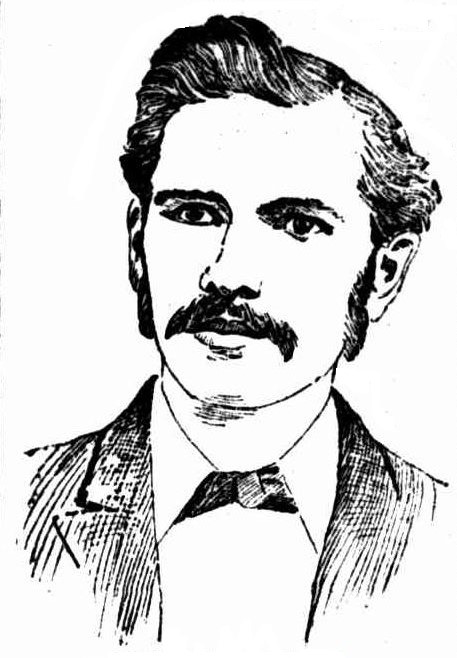
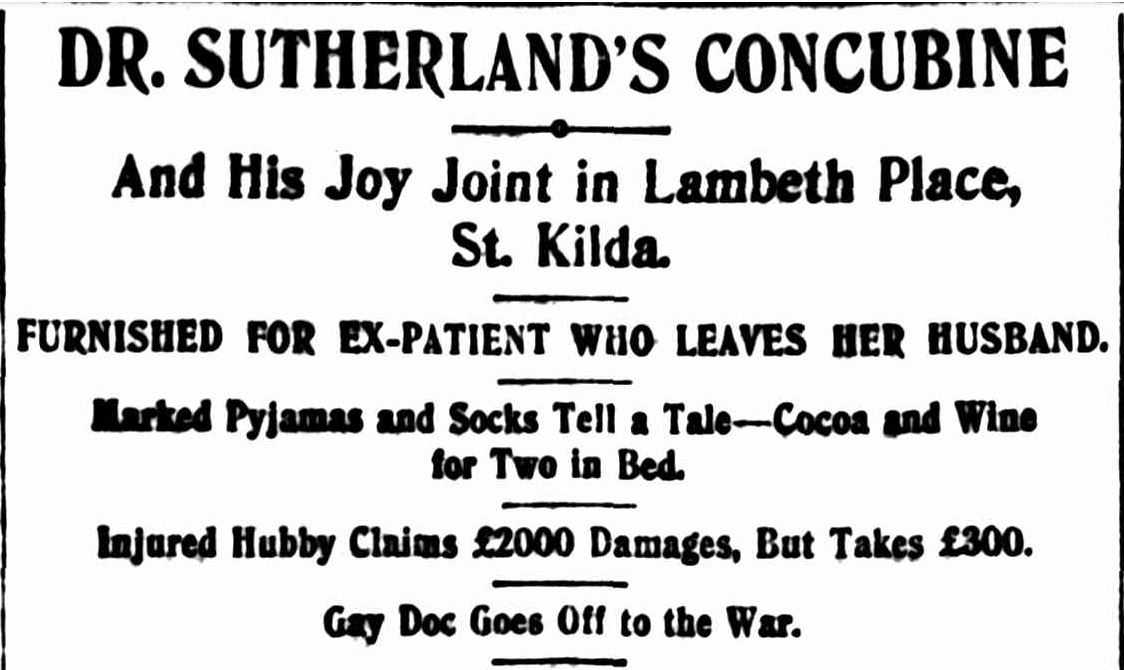




What an interesting gallery of rogues!
‘Interesting’ is correct Carmel. I’m sure there were more. These were just the ones who got caught!
Hi Jenny, what a fabulous collection of ‘dubious old dudes’ – all shining examples of dubiety so brilliant you could pop them in your crystal cabinet alongside the crystal birds and butter dishes.
I want to know more about the introductions. It would be so interesting to examine marriages involving unusual circumstances that might have involved an introduction at Holt’s – say farmers from regional areas marrying city girls where one can’t imagine where they met. I have a great-great aunt who got on a boat in Port Melbourne and went off to South Africa to marry a Welsh carpenter working way off in the interior. How did they ever meet.
Well researched and with a good eye for a story once more. Good work!
Thanks Lenore. You are too kind. Not sure about another post on the marriages, as I am currently a bit over religious fanatics and general lunatics. Unfortunately none of Holt’s Matrimonial Gazettes have survived in public collections, which would be part of that research. There are several surviving examples from Weldon’s in Sydney in the 1890s and I expect they would be the same. I have a few marriage certificates for ceremonies conducted at Holt’s in the late 1890s but perhaps I should look into the ones that ended up in court as well. A post about the Free Christian Church would also be in order, but I have other posts to finish before I get there. These lunatics were just a distraction from a more important post coming up.